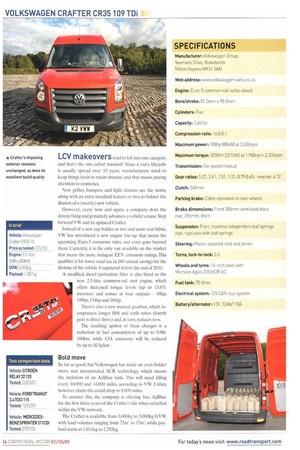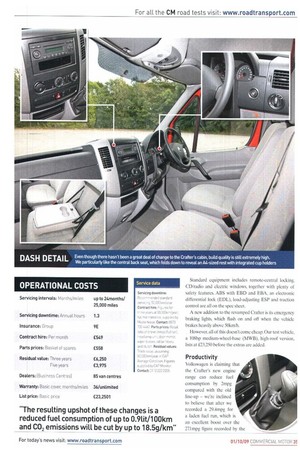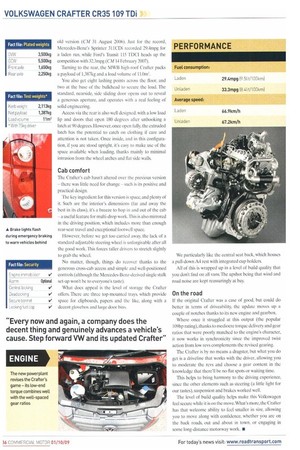LCV makeovers tend to fall into one category. and that's
Page 34

Page 35

Page 36

If you've noticed an error in this article please click here to report it so we can fix it.
the one called 'minimal: Since a van's lifecycle is usually spread over 10 years, manufacturers need to keep things fresh to retain interest, and that means paying attention to cosmetics.
New grilles, bumpers and light clusters are the norm, along with an extra standard feature or two to bolster the illusion of a (nearly) new vehicle.
However, every now and again, a company does the decent thing and genuinely advances a vehicle's cause. Step forward VW and its updated Crafter.
Instead of a new cup holder or two and some seat fabric, VW has introduced a new engine line-up that meets the upcoming Euro-5 emissions rules, and even goes beyond them. Currently, it is the only van available on the market that meets the more stringent EEV emissions ratings. This qualifies it for lower road tax (a £60 annual saving) for the lifetime of the vehicle if registered before the end of 2010.
A modified diesel particulate filter is also fitted to the new 2.5-litre common-rail unit engine, which offers increased torque levels (up to 13.6% increase) and comes in four outputs — 88hp, 108hp, 134hp and 161hp.
There's also a new manual gearbox, which incorporates longer fifth and sixth ratios (fourth gear is direct drive) and, in turn, reduces revs.
The resulting upshot of these changes is a reduction in fuel consumption of up to 0.91it/ 100km, while CO2 emissions will be reduced
by up to 18.5g/km.
Bold move
So far so good. but Volkswagen has made an even bolder move and incorporated SCR technology, which means the inclusion of an AdBlue tank. This will need filling every 10,000 and 14,000 miles, according to VW. Critics, however, claim this could drop to 8,000 miles.
-1:o counter this, the company is offering free AdBlue for the first three years of the Crafter's life when refuelled within the VW network.
The Crafter is available from 3,000kg to 5,000kg GVW, with load volumes ranging from 7.5m2 to 17m3, while payload starts at 1,011kg to 2,392kg. Standard equipment includes remote-central locking, CD/radio and electric windows, together with plenty of safety features. ABS with EBD and EBA, an electronic differential lock (EDL), load-adjusting ESP and traction control are all on the spec sheet.
A new addition to the revamped Crafter is its emergency braking lights, which flash on and off when the vehicle brakes heavily above 50km/h.
However, all of this doesn't come cheap. Our test vehicle, a 108hp medium-wheel-base (MWB), high-roof version, lists at £23,250 before the extras are added.
Productivity
Volkswagen is claiming that the Crafter's new engine range can reduce fuel consumption by 2mpg compared with the old line-up — we're inclined to believe that after we recorded a 29.4mpg for a laden fuel run, which is an excellent boost over the 271mpg figure recorded by the
old version (CM 31 August 2006). Just for the record, Mercedes-Benz's Sprinter 311CDi recorded 29.4mpg for a laden run, while Ford's Transit 115 TDC1 heads up the competition with 32.3mpg (CM 14 February 2007).
Turning to the rear, the MWB high-roof Crafter packs a payload of 1,387kg and a load volume of 11.0m3.
You also get eight lashing points across the floor, and two at the base of the bulkhead to secure the load. The standard, nearside, side sliding door opens out to reveal a generous aperture, and operates with a real feeling of solid engineering.
Access via the rear is also well designed, with a low load lip and doors that open 180 degrees after unhooking a latch at 90 degrees. However, once open fully, the extruded latch has the potential to catch on clothing if care and attention is not taken. Once inside, and in this configura tion, if you are stood upright, it's easy to make use of the space available when loading, thanks mainly to minimal intrusion from the wheel arches and flat side walls.
Cab comfort The Crafter's cab hasn't altered over the previous version there was little need for change such is its positive and practical design.
Ile key ingredient for this version is space, and plenty of it. Such are the interior's dimensions (far and away the best in its class), it's a breeze to hop in and out of the cab a useful feature for multi-drop work.This is also mirrored in the driving position, which includes more than enough rear-seat travel and exceptional footwell space.
However, before we get too carried away. the lack of a standard adjustable steering wheel is unforgivable after all the good work. This forces taller drivers to stretch slightly to grab the wheel.
No matter, though, things do recover thanks to the generous cross-cab access and simple and well-positioned controls (although the Mercedes-Benz-derived single stalk set-up won't he to everyone's taste).
What does appeal is the level of storage the Crafter offers, There are three top-mounted trays, which provide space for clipboards, papers and the like, along with a decent glovebox and large door bins.
We particularly like the central seat back, which houses a pull-down A4 rest with integrated cup holders.
All of this is wrapped up in a level of build quality that you don't find on all vans. The upshot being that wind and road noise are kept reassuringly at bay.
On the road If the original Crafter was a case of good, but could do better in terms of driveability, the update moves up a couple of notches thanks to its new engine and gearbox.
Where once it struggled at this output (the popular 109hp rating), thanks to mediocre torque delivery and gear ratios that were poorly matched to the engine's character, it now works in synchronicity since the improved twist action from low revs complements the revised gearing.
The Crafter is by no means a dragster, but what you do get is a driveline that works with the driver, allowing you to moderate the revs and choose a gear content in the knowledge that there'll be no fiat spots or waiting time.
This helps to bring harmony to the driving experience, since the other elements such as steering (a little light for our tastes), suspension and brakes worked well.
The level of build quality helps make this Volkswagen feel secure while it is on the move. What's more, the Crafter has that welcome ability to feel smaller in size, allowing you to move along with confidence, whether you are on the back roads, out and about in town, or engaging in sonic long-distance motorway work. •












































































































































